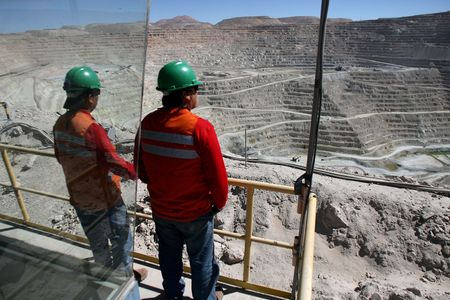By Clara Denina and Helen Reid
JOHANNESBURG (Reuters) – High costs and the prospect of shrinking earnings have made big miners nervous about expansion, even as shareholders demand investment in response to robust commodity prices, China’s reopening and the role of minerals in decarbonising the economy.
Although years of cost discipline have repaired balance sheets from past over-spending, full-year results announcements in February are expected to show a fall in miners’ earnings and in shareholder payouts from the record levels reported in 2022 after disruptions lowered output and costs rose for energy, explosives and equipment.
Disruptions at copper mines caused by extreme weather and labour issues, for example, are predicted to worsen, likely affecting a record 1.6 million tonnes of production this year, Goldman Sachs analysts say, a headache for companies hunting for minerals to power the green energy boom as their deposits get depleted.
“Having cut back on CapEx and spending, mining companies are fine in the short term, but if they look a few years forward, they need to start developing more growth options,” George Cheveley, portfolio manager at Ninety-One, said.
“It is an increasing issue, because if you haven’t been spending a lot on development or cut back, as they all have since prices fell in 2015-16, you can’t do that forever and expect to continue to grow,” he added.
Capital spending by mining companies is set to decrease 11% in 2023, with exploration spending likely to fall by 10%-20%, according to S&P Global Commodity Insights’ principal metals and mining analyst Kevin Murphy.
Despite the vast volumes of copper, lithium, nickel and cobalt needed for the transition to a lower-carbon economy, the majors have limited plans to develop mines that take several years to turn a profit.
Among the more bullish CEOs, Mark Bristow of Barrick Gold said mining companies should spend more on exploration to ensure a solid pipeline of mines, despite the global economy being “extremely stressed”.
“The first thing the mining industry does when it’s under pressure is to stop spending. But at the end of the day, the best time to grow your business is in the trough,” Bristow said.
Some companies have preferred to grow through acquisitions, investing in projects belonging to smaller developers.
The world’s largest listed mining company BHP Group has in the past months bought 20% of Canadian exploration company Brixton Metals and signed a deal with Canada’s Mundoro Capital to explore for copper in Serbia.
It has also made a $6.5 billion cash offer for copper and gold producer OZ Minerals.
A difficult economic backdrop could boost deal-making, which represents an opportunity for the stronger players wanting to acquire proven assets and smaller players seeking to cash in.
“It could be a really interesting catalyst for M&A, because there could be a softening in share prices if people really don’t believe in the fundamentals,” said Sandra du Toit, who leads the Africa M&A practice at Ernst & Young.
Exploring for new mines is highly cyclical https://www.reuters.com/graphics/MINING-INDABA/egvbymzajpq/chart.png
AFRICAN RESOURCES TEMPTING BUT TRICKY
Aside from China, where the lifting of protracted COVID-19 restrictions is expected to drive demand for metals, the main engines of global growth – the United States and Europe – will slow this year, according to the IMF and World Bank, despite signs of stabilising inflation.
The economic contraction makes “unlocking African mining investment” – this year’s theme for the Investing in African Mining Indaba conference in Cape Town at the start of February – an even more challenging goal.
Mining companies’ overall spending on exploration in Africa has declined relative to Australia, Canada and Latin America.
Last year, the share of exploration budgets dedicated to Africa was the smallest since at least 1997, S&P Global Commodity Insights data shows.
Much of that decline is due to small mine developers shifting from Africa, while major producers increased their share of spending on the continent last year, according to S&P’s Murphy.
Major miners have long been wary of the continent because of its risk profile, but a drive by the United States and Europe to reduce their dependence on China, which dominates the processing of battery minerals, is persuading companies to reconsider.
Mining companies spend less on Africa exploration https://www.reuters.com/graphics/MINING-INDABA/jnpwywqampw/chart.png
Anglo American in May took control of the Zambia copper-cobalt licences of junior exploration firm Arc Minerals, while the European Union partnered with Namibia as one of the countries it hopes will help its battery sector build-out.
“There are not a lot of regions with quality ore bodies yet to be exploited,” said Kostas Bintas, co-head of metals at global commodities trader Trafigura.
“Africa, and especially Democratic Republic of Congo and Zambia, still has untapped high-quality copper deposits with relatively high grades. DRC and Zambia are two countries where you can increase copper supply significantly to meet demand.”
(Reporting by Clara Denina in London and Helen Reid in Johannesburg; editing by Barbara Lewis)


